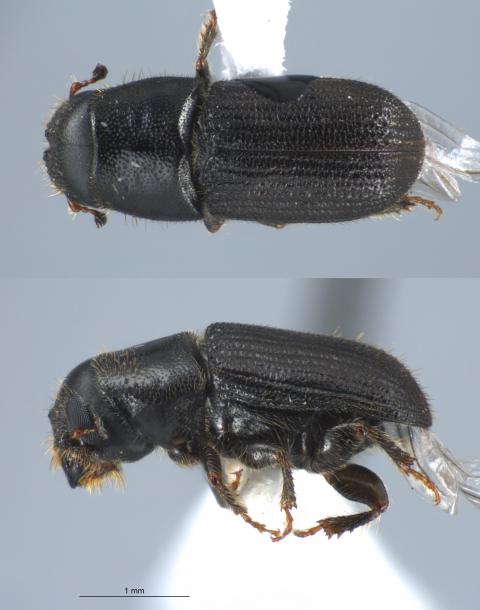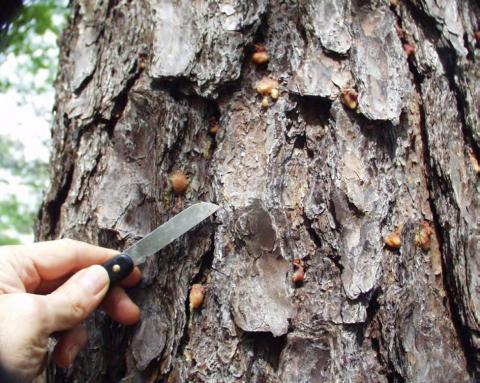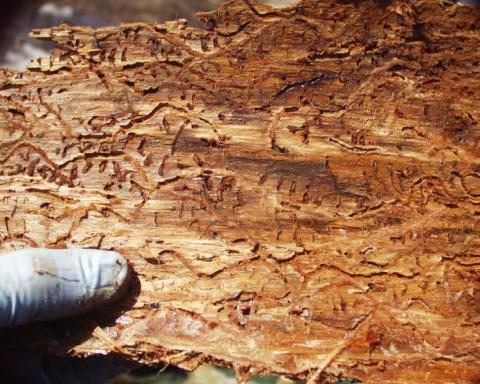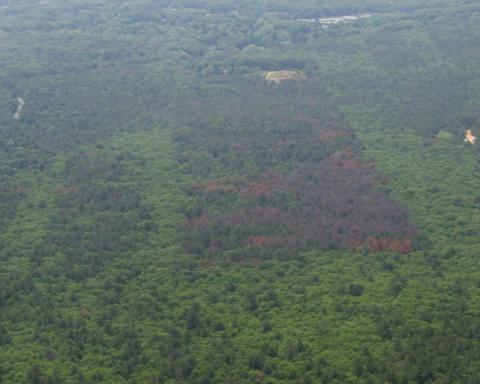The Southern Pine Beetle (Dentroctonus frontalis) is a bark beetle which is native to the southeastern United States and Central America where it is a serious pest of pine forests. In recent years this insect has been expanding its range northwards, likely due to a warming of extreme winter temperatures. The historic northern limit of the Southern Pine Beetle has been New Jersey it but has recently been detected in New York in 2014, and Connecticut, Massachusetts, and Rhode Island in 2015.
This October, Caroline Kanaskie, a graduate student at the University of New Hampshire, captured several adult beetles in traps at two locations in Ossipee and Madison, the first detections in the state and the most the most northerly observations of Southern Pine Beetle to date. This recent northern expansion has led to serious tree mortality of pitch pine on Long Island in New York, but all detections in New England have been in traps with no infested trees observed in the field.

Southern Pine Beetle Adult (Photo-Marc DiGirolomo, USFS)
Given its prevalence throughout southern New England, it is likely these recent detections in New Hampshire represent natural range expansion of southern pine beetle and that populations are probably now endemic in pitch pine forests throughout the state. In the southeastern United States the preferred hosts are loblolly, shortleaf, pond, and Virginia pines. In the northern portion of its range it prefers pitch pine, but has occasionally been observed attacking white pine, Scotch pine and Norway spruce during outbreak events.
Southern pine beetle has a cyclical population dynamic where it will exist on the landscape at near undetectable levels for years at a time but can rapidly enter an outbreak phase where localized population levels spike resulting in “hot spots” of tree mortality. Infested trees can be identified by the presence of pitch tubes at the location of attack points on the outer bark of the trunk along with orange frass in bark crevices, and in heavily infested trees distinctive S-shaped galleries below the bark and discoloration of foliage. Adult beetles are dark reddish brown to black and about 3mm in body length, while larvae are crescent shaped and about the size of a grain of rice. Upon selecting a suitable host tree, female beetles will begin to bore into the trunk while attracting males via release of aggregation pheromones. At endemic levels most attacks pitched out by the tree, but during outbreaks the number of attacking beetles will overwhelm the trees defenses.

Pitch Tubes (Photo-Kyle Lombard)

Larval Galleries (Photo-Kyle Lombard)

Declining Trees in NY (Photo-Kyle Lombard)
Pitch pine forests are not common in New Hampshire but they are ecologically significant as they occupy areas with sandy, nutrient poor soils and frequent fire regimes, which few our native trees species are suited to colonize. These forests also host an abundance rare plants and support unique floral communities. Risk of southern pine beetle outbreaks increase as tree density within a stand increases, therefore preemptive thinning can reduce the risk of an outbreak, however, the risk of such an outbreak in New Hampshire the near future is low. To date, the most northern outbreaks have occurred within Long Island Central Pine Barrens in New York, with no infested trees yet found in New England. As this beetle continues to expand its range northward we expect outbreaks to pop up in the southern New England states, which have less severe winters and more expansive pitch pine forests, well before conditions are suitable for outbreaks in our state. We will continue to monitor the situation in our neighbors to the south, but currently there is not an immediate cause for alarm here in New Hampshire.
More About Southern Pine Beetle
Southern Pine Beetle Fact Sheet
New York State Department of Environmental Conservation
US Forest Service

